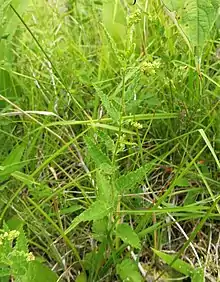| Tragia urticifolia | |
|---|---|
 | |
| Scientific classification | |
| Kingdom: | Plantae |
| Clade: | Tracheophytes |
| Clade: | Angiosperms |
| Clade: | Eudicots |
| Clade: | Rosids |
| Order: | Malpighiales |
| Family: | Euphorbiaceae |
| Genus: | Tragia |
| Species: | T. urticifolia |
| Binomial name | |
| Tragia urticifolia Michx., 1803 | |
Tragia urticifolia, commonly called nettleleaf noseburn,[1] is a species of flowering plant in the spurge family (Euphorbiaceae). It is native eastern to North America, where it is found in the southeastern United States.[2][3] Its typical natural habitat is in rocky or sandy dry woodlands, over calcareous or mafic substrates.[3][4]
Tragia urticifolia is an erect perennial herb or subshrub. Its leaves are triangular-lanceolate, truncate to cordate at the base, with an acute to acuminate tip. Its petioles are around 3–15 mm. It produces small yellow flowers from late spring through summer. Tragia urticifolia can be distinguished from the similar looking Tragia betonicifolia by its longer pedicels on staminate flowers (1.5–2 mm), which are more evenly distributed in the raceme.[3]
This species is notable for having stinging hairs that are very painful upon contact with skin.[5]
References
- ↑ USDA, NRCS (n.d.). "Tragia urticifolia". The PLANTS Database (plants.usda.gov). Greensboro, North Carolina: National Plant Data Team. Retrieved 17 January 2019.
- ↑ "Tragia urticifolia". County-level distribution map from the North American Plant Atlas (NAPA). Biota of North America Program (BONAP). 2014. Retrieved 21 January 2019.
- 1 2 3 Tragia urticifolia Flora of North America
- ↑ Weakley, Alan (2015). "Flora of the Southern and Mid-Atlantic States".
- ↑ Diggs, George; Lipscomb, Barney; O'Kennon, Robert (1999). Flora of North Central Texas. Botanical Research Institute of Texas. p. 616.